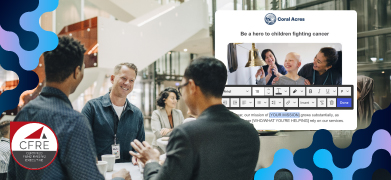Nonprofit storytelling isn’t a “nice-to-have,” it’s a fundamental part of your work. Your organization’s powerful stories are the foundation of your identity, showing who you are as people, what you do to make a difference in your community, and what makes you unique to other nonprofits doing similar work. These stories provide a narrative that resonates with donors emotionally and inspires them to give energetically.
Our 2022 DonorPerfect conference attendees told us they’ve experienced challenges telling their organization’s stories due to the confidential nature of their work. Nonprofits in the human services and medical sectors, specifically, run into this often. They wonder, how can we represent our beneficiaries – with dignity – without using their names, faces, or voices?
Frequently Asked Questions
“Our nonprofit is for victims of domestic and sexual violence. All work/client experiences are confidential to protect clients. How can we use storytelling?”
– Joelyn, Community Outreach/Administrative Coordinator
“We are a shelter and we cannot show our kids’ faces… how can we still capture our audience’s attention? We run into visual challenges at times.”
– Beth, Grant Coordinator
“How can we do this and not trigger the audience into trauma responses?”
– Mary, Director of Development & Communications
How to represent those you serve with dignity
HIPAA laws aside, there are many reasons why nonprofits vow to keep these details private. For some, confidentiality is a precautionary measure – mitigating potential risks to children and other vulnerable individuals. For others, anonymity is requested by the individual due to the sensitive information included in their story.
Online and digital fundraising practices allow for creative problem-solving – you can still tell your beneficiaries’ stories through donation forms, web pages, and social media without disclosing their sensitive information.
STORY DETAILS
Demographics
There are several options to create a sense of identity while still upholding confidentiality. First, you can use first names only, and/or change names with a disclaimer.
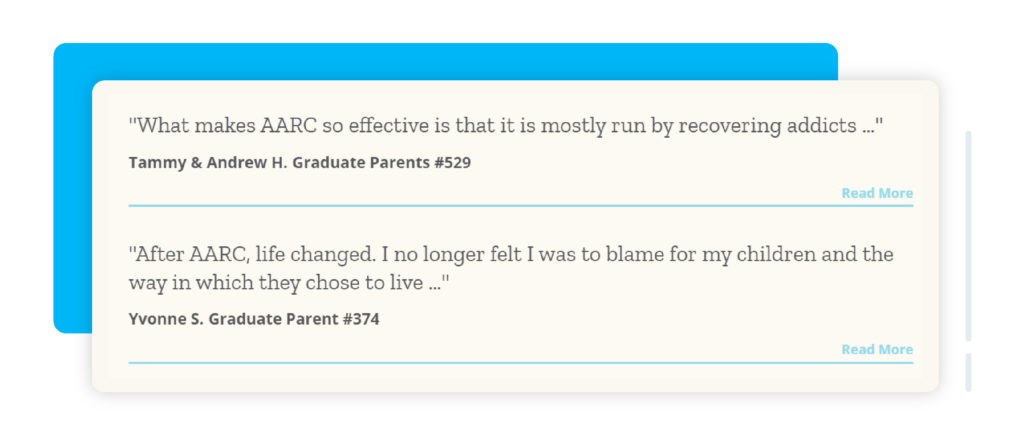
DonorPerfect client, Alberta Adolescent Recovery Centre
You don’t have to list where the storyteller is from, their age, or anything that could breach your confidentiality agreement. The story will still resonate as long as it is honest and heartfelt. See an example below with no personal details, that still paints a picture of the person telling the story.
Ex. A young woman came to us after sleeping on the floor of a friend’s apartment with her two-year-old daughter for several months. We’ll call her Kelly and her daughter Kate, for their protection. Kelly comes from a single-income family that couldn’t afford to send her to school, and she was left to her own devices to make ends meet. Some trouble with the law as a teenager has made it hard for her to find work. When she had Kate, she had little to her name.
Within a week of meeting Kelly and her daughter, we were able to secure them a cozy two-bedroom bungalow near the lake using donations from our Fresh Start Fund. Their new home is nestled in the same cul-de-sac as other young women we’ve been able to help. Kate has playdates with her young neighbors, and Kelly has a network of support right up the street. Together, they take walks around the lake and talk about the beauty of life. “I found my home base. I know that hard days are behind me,” says Kelly, “and I can finally look forward to the future.”
Participants
Keep in mind that you can ask beneficiaries for consent to share their stories, and if interested, what they would be comfortable sharing. If you are having trouble finding someone to share, or don’t feel comfortable asking, try talking to family members or caregivers who may have been impacted as well. Their stories are an important part of your work, too, as they are extremely close to it. You can also interview your own program directors and volunteers – have them walk through their typical day of working with and caring for your beneficiaries.
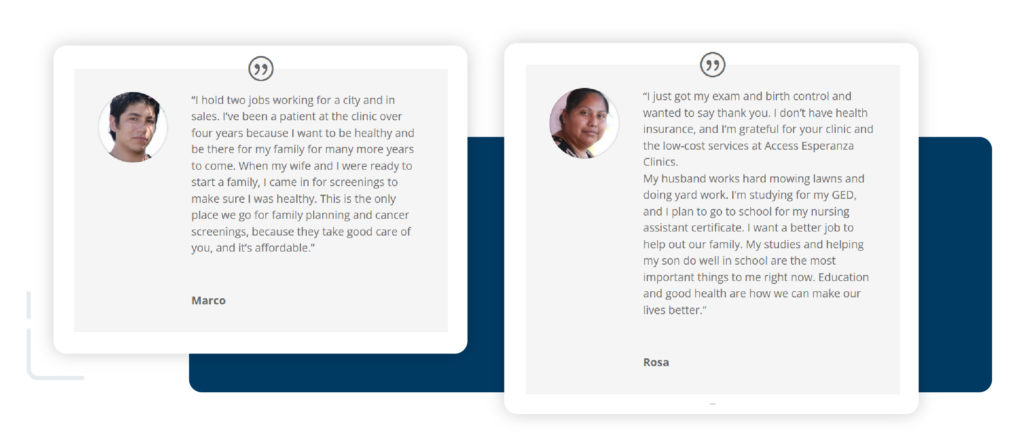
DonorPerfect client, Access Esperanza Clinics
Angle
Imagine you’re a first-time visitor to your website, looking for a program, service, or event that will help you explore your options and get back on your feet. Maybe you’re looking for resources to help a friend or family member. What would speak to your situation, specifically? What would signify to you that a program was designed for you or your loved ones’ needs?
“Our nonprofit has five programs that serve different populations so it is easy to overcomplicate, especially to new listeners. We are working on being more intentional about storytelling, one program at a time, depending on the audience.”
– Kimberly, Donor Relations Assistant
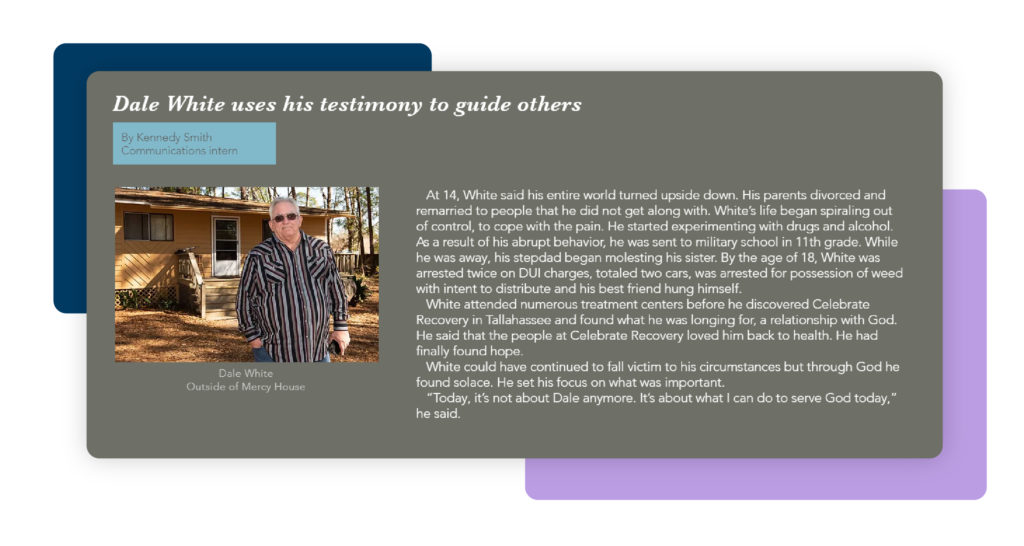
DonorPerfect client, Good News Outreach
STORY IMAGERY
Avoid faces
There are plenty of ways to make a connection to your audience while still respecting your client’s privacy and confidentiality. To avoid showing their faces, you can play with bird’s eye views, photos taken from behind, or photos of a person’s hands or body in action (writing, studying, passing out food, etc.). It’s not the person’s physical being that your website visitors are relating to, it’s their thoughts, feelings, and struggles.
Take advantage of eye contact when possible
If featuring someone who doesn’t mind showing their face, like a family member or willing beneficiary, try to use photos or videos of them looking directly at the camera to establish a deeper connection with the reader. Encourage them to share personal stories or values that the reader can grasp onto and resonate with. Keep in mind that even if you use a photo of someone, it’s not necessary to include their name. Give their story a title instead.
Get creative with graphics
Remember: You don’t need photos of people to produce great visual resources. Free tools like Canva allow you to create confidential stories in literal seconds – making client quotes, stories, and program descriptions pop with graphic elements.
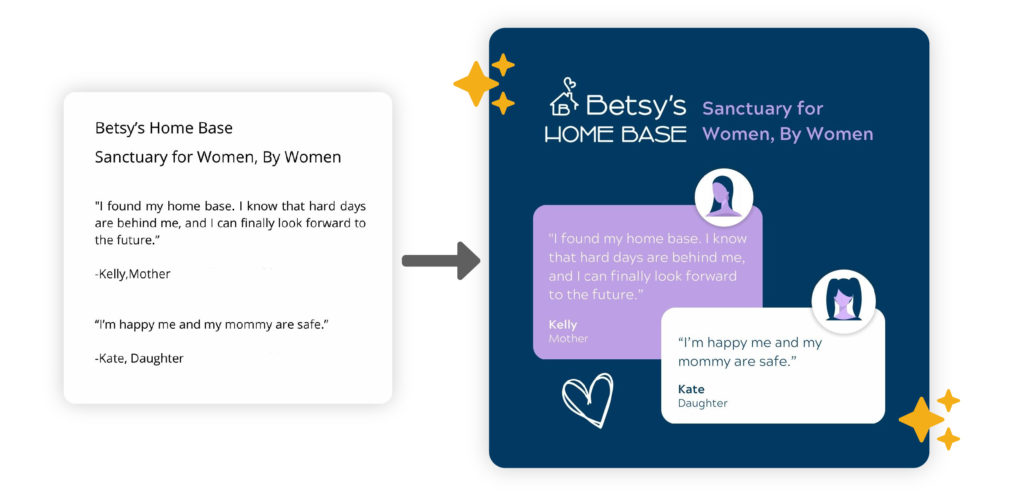
Graphic made using canva.com
Use stock images
If you’re feeling like you’re out of visual options, stock images are a reliable source to lean on. While they may not depict the actual people you are serving, they represent the people you serve. After all, your organization welcomes people from all walks of life, who on the surface may not look like a stereotypical client or patient of yours.
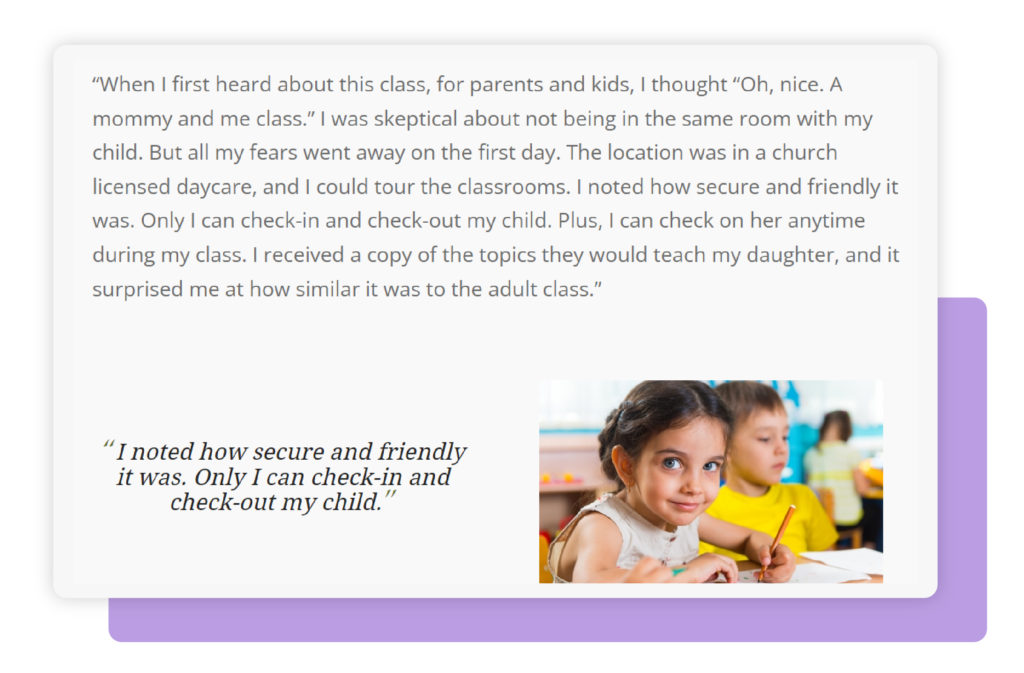
DonorPerfect client, ACE Overcomers
If necessary, let beneficiaries tell their own stories
If you’re worried about triggering your clients by asking for their stories or aren’t sure how to tell them with dignity, let them do it themselves. They can make up a name if they wish, use a nickname, and add their own photo. It doesn’t matter if they choose a photo of a sunset instead of their face – that sunset could represent a new appreciation for the little things in life, and their story remains the same.
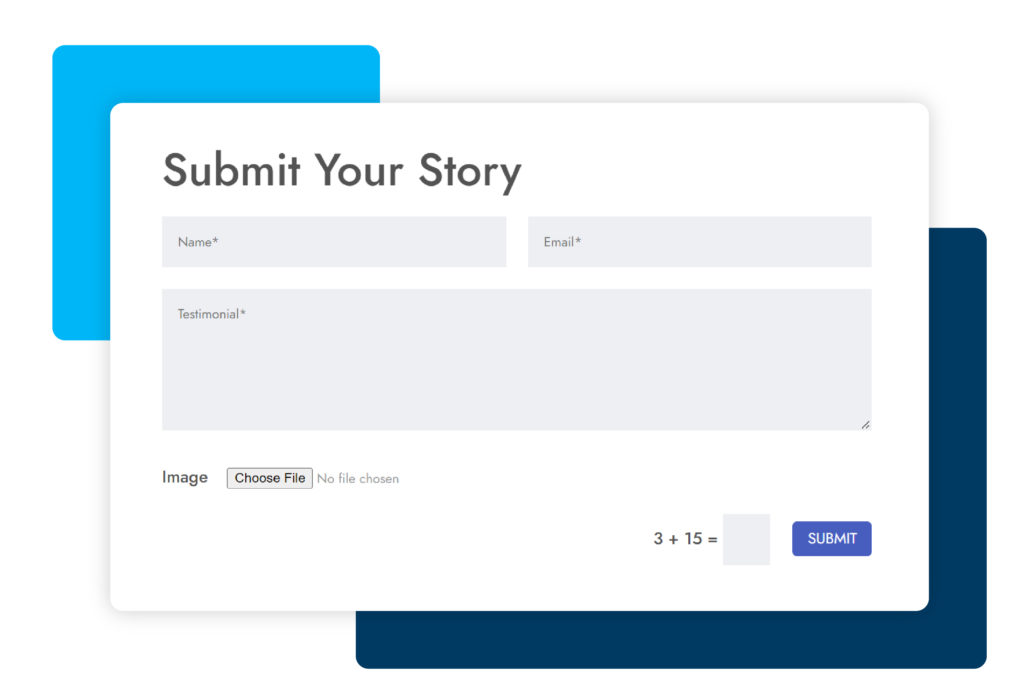
DonorPerfect client, Aid to Victims of Domestic Abuse
Storytelling best practices for your nonprofit website
Prioritize storytelling over specs
Most nonprofits include a lengthy About section on their website so the beneficiary can get a feel for the team that will be helping them. Still, credentials and program descriptions don’t necessarily translate to impact. When seeking help, your beneficiaries are much more concerned with how these programs will help their situation, specifically. Personal stories are the best way to illustrate this information and evoke an emotional response, so try to strike a balance between sharing client experiences and cold hard facts.
You can even provide About information in the form of a story. Instead of listing where your staff went to school or served before, encourage them to write about their personal reasons for getting involved in this work. Try filming a short video with your staff so website visitors can get to know you and establish a personal connection.
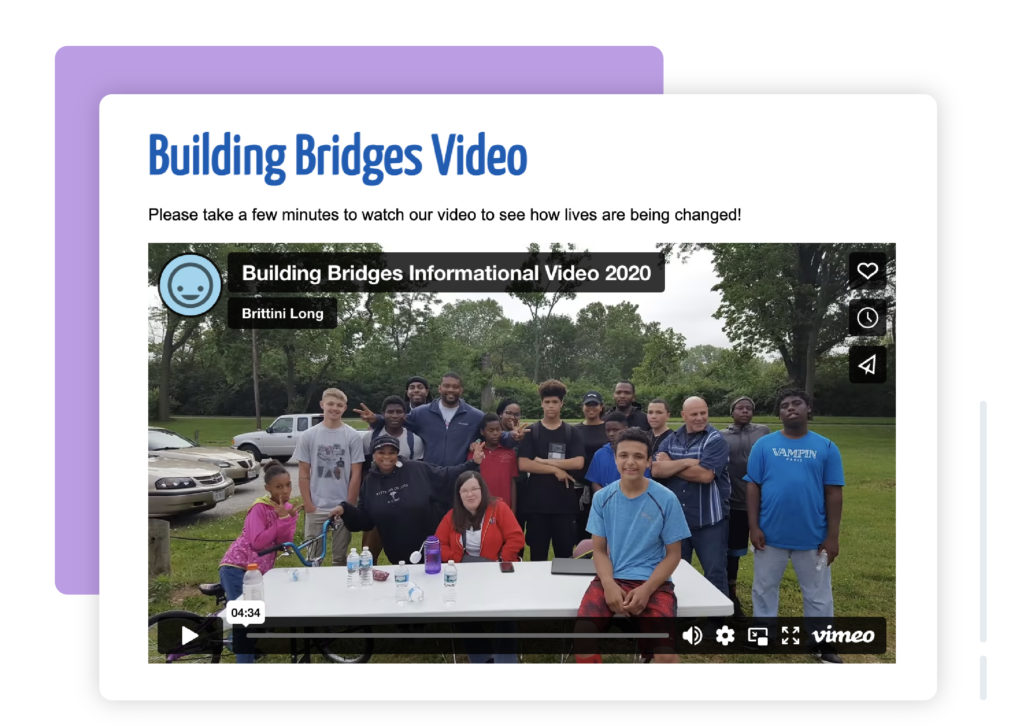
DonorPerfect client, Building Bridges
Create a clear path to your stories
Your storytelling should be a part of your website navigation so visitors can easily put themselves in the shoes of your past and current beneficiaries, and decide if your programs are right for their needs. Even if you’ve given your storytelling a specific title – ex. Our Heroes, Community Voices, etc. – make sure these stories have their own designated section on your website, rather than peppering them throughout your website pages.
Why? If someone is skimming through your website, curious about the first steps to getting help, stories that are strewn throughout will be easy to miss, and harder to resonate with. For example, in situations of abuse, it’s possible that your website visitors won’t know that they need help until they have heard from or connected with others experiencing abuse.
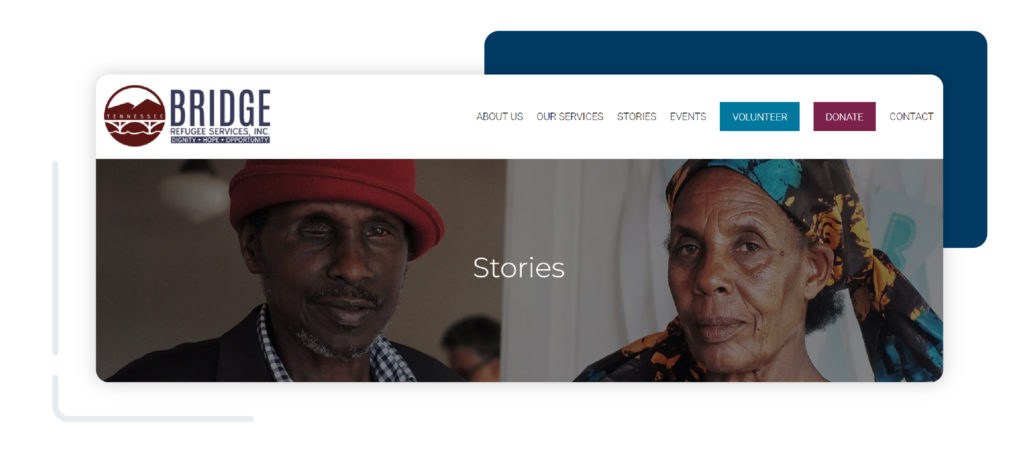
DonorPerfect Client, Bridge Refugee Services
Designate a place for your stories, ex:
- Blog or newsletter
- Stories section
- Impact section
- Community section
- Homepage slider
- Photo gallery with captions
Remember we’re here to help
At DonorPerfect, we feel it’s our duty to help ensure your nonprofit stories are heard, respectful to those you serve, and demonstrate hope to those in need or danger. We invite you to come to us anytime with your questions or suggestions. See a fundraising tool you’re curious about, or have an idea for a new feature in your system? Let us know. Our services are built on and influenced by your feedback, and we simply want what’s best for you and your beneficiaries.
Want more help with nonprofit storytelling? Head over to donorperfect.com/conference to watch recordings from our 2022 Community Conference, Stories Worth Sharing. We gathered with industry experts and thought leaders to share best practices and tools to bring your nonprofit stories to life.







